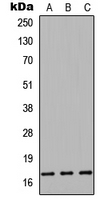
WB analysis of HEK293T (A), Raw264.7 (B), PC12 (C) whole cell lysates using GTX56093 CST9L antibody.
CST9L antibody
GTX56093
ApplicationsWestern Blot
Product group Antibodies
ReactivityHuman, Mouse, Rat
TargetCST9L
Overview
- SupplierGeneTex
- Product NameCST9L antibody
- Delivery Days Customer9
- Application Supplier NoteWB: 1:500 - 1:1000. *Optimal dilutions/concentrations should be determined by the researcher.Not tested in other applications.
- ApplicationsWestern Blot
- CertificationResearch Use Only
- ClonalityPolyclonal
- ConjugateUnconjugated
- Gene ID128821
- Target nameCST9L
- Target descriptioncystatin 9 like
- Target synonymsbA218C14.1; CTES7B; cystatin-9-like; testatin; testicular tissue protein Li 45
- HostRabbit
- IsotypeIgG
- Protein IDQ9H4G1
- Protein NameCystatin-9-like
- Scientific DescriptionThe cystatin superfamily encompasses proteins that contain multiple cystatin-like sequences. Some of the members are active cysteine protease inhibitors, while others have lost or perhaps never acquired this inhibitory activity. There are three inhibitory families in the superfamily, including the type 1 cystatins (stefins), type 2 cystatins and the kininogens. The type 2 cystatin proteins are a class of cysteine proteinase inhibitors found in a variety of human fluids and secretions. The cystatin locus on chromosome 20 contains the majority of the type 2 cystatin genes and pseudogenes. This gene is located in the cystatin locus and encodes a protein similar to mouse cystatin 9. Based on its testis-specific expression, it is likely to have a role in tissue reorganization during early testis development. [provided by RefSeq, Jul 2008]
- ReactivityHuman, Mouse, Rat
- Storage Instruction-20°C or -80°C,2°C to 8°C
- UNSPSC12352203
